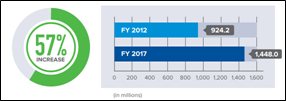Most investors don’t know it, but wholesaling used cars is a red-hot business. This is why Copart Inc. (CPRT) should be on your radar, writes Jon Markman.
Since 1982, Copart Inc. has been in the business of remarketing fleet, dealer, reprocessed and salvaged vehicles. A company that began on a single lot in California is now a global enterprise.
That business is about to get even hotter.
No need to spend all day at the car dealer anymore. You can attend online auto auctions and get a treasure that was relegated to the trash heap. And Copart is making a mint in the meantime.
Twenty years ago, the used car business consisted of trade-ins. Buyers traded their old car for a new one. And then the dealer put it at the back of the lot or wholesaled it at a small local auction.
It was an ecosystem with many dealers, mechanics and guaranty insurers. Each got their piece of the pie.
Other vehicles came from rental companies. The rest were salvaged from insurance companies after accidents or natural disasters. These sellers were motivated to liquidate their inventory as quickly as possible.
In the early 1980s, Willis Johnson had a bright idea. He started Copart to consolidate the transactional parts of this fragmented ecosystem. A decade later, the company had four northern California lots.
In 1997, as the internet fervor hit full throttle, Johnson veered toward information technology. For the first time, large networked inventories were viewable. Reports were available. A year later, the Copart Auction System meant that buying and selling entire fleets of rental vehicles was a few mouse-clicks away.
The system was revolutionary. So much so that, in 2003, Copart stopped selling cars at live auctions so it could focus on internet auctions.
In its 2004 10-K filing with the Securities and Exchange Commission, Copart managers laid out a grand vision for the future. The company would continue to acquire auction sites but defer buyers and sellers to its internet virtual bidding system.
Sites were snapped-up in Oregon, Ohio, Alaska, Montana and Toronto, Canada. Sales swelled to $400.8 million. Profits were $124.8 million. Better still, its sellers, mostly insurance companies, received better prices because virtual bidding boosted the number of potential buyers.
Copart managers built a purely transactional business in the model of Visa (V) and eBay (EBAY).
Most vehicles are sold on consignment. The company collects a fee for the auction and value-added services like towing, processing and storage. And because the company has so many auction locations, plus best-in-class IT infrastructure, choosing Copart is a no-brainer for most large sellers.

Managers have aggressively pursued national and regional supply agreements from insurers, fleet operators, banks, leasing companies and auto dealers. They have also continued to acquire strategically located auction sites, both in the U.S. and internationally.
The business is accelerating away from the competition.
Today, the Copart platform has 750,000 members in over 170 countries. It has operations at 200 locations, in 11 countries, and offers 125,000 vehicles available for auction every day. Last year, it sold more than 2 million vehicles. And there is no end in sight for growth.
Statista, an online data analytics company owned by Dell Technologies, reports that there were 13 million traffic crashes in the U.S. in 2016. That number is on the rise because people are driving more miles, and they are more distracted.
It’s a strange phenomenon: Cars are becoming safer, yet accidents, and especially fatalities are rising, leading to even more total write-offs by insurers.
All of this plays to Copart’s strengths.

Copart’s revenues have gained 57% over the past five years, and its stock is up almost 35% just this year. The company is collecting a series of lucrative fees every time a salvaged vehicle hits one of its many lots.
In May, the company reported third-quarter financial results. Sales soared 27% to $478.2 million. Income rose 40.6% to $127.3 million. The top-line result put sales at $1.4 billion for the first nine months of fiscal 2018. That’s 26% ahead of the pace set a year ago. And its revenues are 57% ahead of where they were in 2012.
Since 2003, Copart shares have advanced an average of 23.4% annually. They are up 34.8% in 2018, driving a market capitalization of $13.5 billion. Even at 37x trailing earnings, this is definitely a stock for your radar.
Best wishes,
Jon D. Markman
P.S. Copart earns a stellar A- Weiss Rating. Millions of investors, professionals and corporations already rely on and trust Weiss Ratings. They offer 53,000 ratings of stocks, mutual funds, banks, insurance companies and more. You can access this independent, unbiased research and analysis FREE for 14 days. Click here to discover how.
Subscribe to Jon Markman’s Power Elite newsletter here
Subscribe to Jon Markman’s Tech Trend Trader here
Subscribe to Jon Markman’s Strategic Advantage here





















